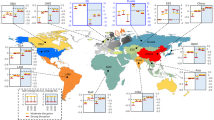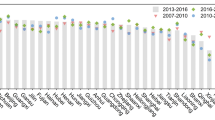Abstract
Hopes are high that removing fossil fuel subsidies could help to mitigate climate change by discouraging inefficient energy consumption and levelling the playing field for renewable energy1,2,3. In September 2016, the G20 countries re-affirmed their 2009 commitment (at the G20 Leaders’ Summit) to phase out fossil fuel subsidies4,5 and many national governments are using today’s low oil prices as an opportunity to do so6,7,8,9. In practical terms, this means abandoning policies that decrease the price of fossil fuels and electricity generated from fossil fuels to below normal market prices10,11. However, whether the removal of subsidies, even if implemented worldwide, would have a large impact on climate change mitigation has not been systematically explored. Here we show that removing fossil fuel subsidies would have an unexpectedly small impact on global energy demand and carbon dioxide emissions and would not increase renewable energy use by 2030. Subsidy removal would reduce the carbon price necessary to stabilize greenhouse gas concentration at 550 parts per million by only 2–12 per cent under low oil prices. Removing subsidies in most regions would deliver smaller emission reductions than the Paris Agreement (2015) climate pledges and in some regions global subsidy removal may actually lead to an increase in emissions, owing to either coal replacing subsidized oil and natural gas or natural-gas use shifting from subsidizing, energy-exporting regions to non-subsidizing, importing regions. Our results show that subsidy removal would result in the largest CO2 emission reductions in high-income oil- and gas-exporting regions, where the reductions would exceed the climate pledges of these regions and where subsidy removal would affect fewer people living below the poverty line than in lower-income regions.
This is a preview of subscription content, access via your institution
Access options
Access Nature and 54 other Nature Portfolio journals
Get Nature+, our best-value online-access subscription
$29.99 / 30 days
cancel any time
Subscribe to this journal
Receive 51 print issues and online access
$199.00 per year
only $3.90 per issue
Buy this article
- Purchase on Springer Link
- Instant access to full article PDF
Prices may be subject to local taxes which are calculated during checkout




Similar content being viewed by others
References
Edenhofer, O. et al. in Climate Change 2014: Mitigation of Climate Change. Contribution of Working Group III to the Fifth Assessment Report of the Intergovernmental Panel on Climate Change (eds Edenhofer, O. et al.) 32–108 (Cambridge Univ. Press, 2014)
International Energy Agency (IEA). Energy and Climate Change. WEO Special Report 2015. https://www.iea.org/publications/freepublications/publication/WEO2015SpecialReportonEnergyandClimateChange.pdf (OECD/IEA, 2015)
Friends of Fossil Fuel Subsidy Reform (FFSR). Fossil Fuel Subsidy Reform and the Communiqué: Briefing Note. http://fffsr.org/wp-content/uploads/2015/06/fffsr_information_for_policymakers-1.pdf (FFSR, June 2015)
IEA, OPEC, OECD and World Bank. Joint Report by IEA, OPEC, OECD and World Bank on Fossil-fuel and Other Energy Subsidies: An update of the G20 Pittsburgh and Toronto Commitments. https://www.oecd.org/env/49090716.pdf (2011)
G20 Leaders’ Communique Hangzhou Summit. https://www.g20.org/profiles/g20/modules/custom/g20_beverly/img/timeline/China/2016-09-04-g20-comunique-en.pdf (2016)
International Energy Agency (IEA). World Energy Outlook 2015. http://www.iea.org/publications/freepublications/publication/WEO2015.pdf (OECD/IEA, 2015)
Russell, C. Oil Price Plunge should Prompt New Fuel Taxes in Asia: Russell. https://www.reuters.com/article/us-column-russell-tax-fuel/oil-price-plunge-should-prompt-new-fuel-taxes-in-asia-russell-idUSKBN0KW1V620150123 (Reuters, 2015)
International Energy Agency (IEA). World Energy Outlook 2016. https://www.iea.org/bookshop/720-World_Energy_Outlook_2016 (OECD/IEA, 2016)
Indonesia’s Economy: A good scrap. Economisthttps://www.economist.com/news/asia/21638179-jokowi-abandons-wasteful-fuel-subsidies-fiscal-prospects-brighten-good-scrap (8 January 2015)
The Organisation for Economic Co-operation and Development (OECD). OECD Inventory of Support Measures for Fossil Fuels 2015. http://www.oecd.org/about/secretary-general/oecd-inventory-of-support-measures-for-fossil-fuels-2015.htm (OECD, 21 September 2015)
International Energy Agency (IEA). World Energy Outlook 2014. https://www.iea.org/publications/freepublications/publication/WEO2014.pdf (OECD/IEA, 2014)
Schwanitz, J., Piontek, F., Bertram, C. & Luderer, G. Long-term climate policy implications of phasing out fossil fuel subsidies. Energy Policy 67, 882–894 (2014)
International Energy Agency (IEA). World Energy Outlook 2011. https://www.iea.org/publications/freepublications/publication/WEO2011_WEB.pdf (OECD/IEA, 2011)
Burniaux, J.-M . & Chateau, J. Mitigation Potential of Removing Fossil Fuel Subsidies. Paper 853, http://www.oecd-ilibrary.org/economics/mitigation-potential-of-removing-fossil-fuel-subsidies_5kgdx1jr2plp-en (OECD, 2011)
Burniaux, J.-M. & Chateau, J. Greenhouse gases mitigation potential and economic efficiency of phasing-out fossil fuel subsidies. Inter Econ. 140, 71–88 (2014)
Coady, D ., Parry, I ., Sears, L. & Shang, B. How Large are Global Energy Subsidies? https://www.imf.org/external/pubs/ft/wp/2015/wp15105.pdf (International Monetary Fund, 2015)
International Energy Agency (IEA). Energy Subsidies. http://www.iea.org/statistics/resources/energysubsidies/ (IEA, accessed 2 May 2017)
Wagner, A. International Fuel Prices 2012/2013. https://www.giz.de/expertise/downloads/giz2014-en-international-fuel-prices-2013.pdf (Deutsche Gesellschaft für Internationale Zusammenarbeit (GIZ), 2014)
Clarke, L. et al. in Climate Change 2014: Mitigation of Climate Change. Contribution of Working Group III to the Fifth Assessment Report of the Intergovernmental Panel on Climate Change (eds Edenhofer, O. et al.) 413–510 (Cambridge Univ. Press, 2014)
Lam, N. L. et al. Kerosene subsidies for household lighting in India: what are the impacts? Environ. Res. Lett. 11, 044014 (2016)
Cameron, C. et al. Policy trade-offs between climate mitigation and clean cook-stove access in South Asia. Nat. Energy 1, 15010–15015 (2016)
Gerasimchuk, I . et al. Zombie Energy: Climate Benefits of Ending Subsidies to Fossil Fuel Production. https://www.iisd.org/sites/default/files/publications/zombie-energy-climate-benefits-ending-subsidies-fossil-fuel-production.pdf (International Institute for Sustainable Development, 2017)
Bast, E ., Doukas, A ., Pickard, S ., van der Burg, L . & Whitley, S. Empty Promises: G20 Subsidies to Oil, Gas and Coal Production. http://priceofoil.org/content/uploads/2015/11/empty_promises_full_report_update.pdf (Oil Change International and Overseas Development Institute, 2015)
Inchauste, G. & Victor, D. G. in The Political Economy of Energy Subsidy Reform (eds Inchauste, G. & Victor, D. G. ) 1–44, https://openknowledge.worldbank.org/bitstream/handle/10986/26216/9781464810077.pdf (World Bank, 2017)
Lockwood, M. Fossil fuel subsidy reform, rent management and political fragmentation in developing countries. New Polit. Econ. 20, 475–494 (2015)
Merrill, L ., Bassi, A. M ., Bridle, R. & Christensen, L. T. Tackling Fossil Fuel Subsidies and Climate Change: Levelling the Energy Playing Field. http://www.iisd.org/library/tackling-fossil-fuel-subsidies-and-climate-change (Norden, 2015)
Matsuo, T. & Schmidt, T. S. Hybridizing low-carbon technology deployment policy and fossil fuel subsidy reform: a climate finance perspective. Environ. Res. Lett. 12, 014002–014010 (2017)
British Petroleum (BP). BP Statistical Review of World Energy 2016 https://www.bp.com/content/dam/bp/pdf/energy-economics/statistical-review-2016/bp-statistical-review-of-world-energy-2016-full-report.pdf (BP, June 2016)
Rogelj, J. et al. Understanding the origin of Paris Agreement emission uncertainties. Nat. Commun. 8, 15748 (2017)
Acknowledgements
The research leading to these results received funding from the European Union’s Seventh Programme FP7/2007-2013 under grant agreement number 308329 (ADVANCE). We thank the International Institute for Applied Systems Analysis, Energy Program for hosting the online database with the scenario data as well as P. Kolp, L. Groihofer and D. Garcia-Carbrera for data and database support; the International Energy Agency (in particular A. Bromhead, L. Cozzi, N. Selmet, G. Zazias and T. Shirai) for providing data and support related to their energy subsidy database; G. Luderer for contributing to the study design; and A. Cherp for commenting on the manuscript.
Author information
Authors and Affiliations
Contributions
J.J., D.McC., V.K. and K.R. designed the experiment (with input from C.B. and M.T.). J.J. compiled the fossil fuel subsidies and energy price data. D.McC. and V.K. provided the MESSAGE model data. J.E. and L.B. provided the WITCH model data. D.E.H.J.G. and D.v.V. provided the IMAGE model data. K.F. and L.P. provided the GEM-E3 model data. C.B. provided the REMIND model data. J.J. made all the figures (with assistance from V.V. and D.E.H.J.G.). J.J. led the analysis of the modelling results and writing of the paper, with input from all authors.
Corresponding author
Ethics declarations
Competing interests
The authors declare no competing financial interests.
Additional information
Reviewer Information Nature thanks H. McJeon, I. Parry and the other anonymous reviewer(s) for their contribution to the peer review of this work.
Publisher's note: Springer Nature remains neutral with regard to jurisdictional claims in published maps and institutional affiliations.
Supplementary information
Supplementary Information
This file contains Supplementary Methods, Code Availability Statement, Supplementary Figures 1-25, Supplementary Tables 1-20, Supplementary Text sections 1-10 and Supplementary References. (PDF 6871 kb)
Rights and permissions
About this article
Cite this article
Jewell, J., McCollum, D., Emmerling, J. et al. Limited emission reductions from fuel subsidy removal except in energy-exporting regions. Nature 554, 229–233 (2018). https://doi.org/10.1038/nature25467
Received:
Accepted:
Published:
Issue Date:
DOI: https://doi.org/10.1038/nature25467
This article is cited by
-
Grooved electrodes for high-power-density fuel cells
Nature Energy (2023)
-
Diesel demand elasticities and sustainable development pillars of economy, environment and social (health): comparing two strategies of subsidy removal and energy efficiency
Environment, Development and Sustainability (2023)
-
Low-carbon city planning based on collaborative analysis of supply and demand scenarios
City and Built Environment (2023)
-
The Impacts of Removing Fossil Fuel Subsidies and Increasing Carbon Taxation in Ireland
Environmental and Resource Economics (2023)
-
Uncovering the significant socio-economic attributes of low- and high-emission countries using rough sets
Clean Technologies and Environmental Policy (2022)
Comments
By submitting a comment you agree to abide by our Terms and Community Guidelines. If you find something abusive or that does not comply with our terms or guidelines please flag it as inappropriate.



